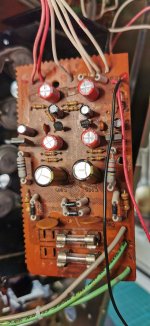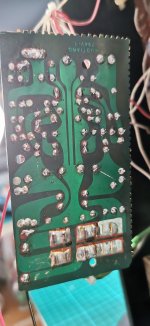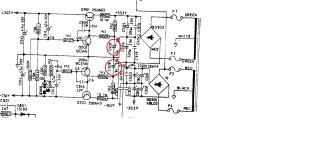so a bit of success.i checked all the resistors and they seem to all be within value.
rather than risk taking all the caps out, andas there were not that many i replaced them all.
after doing that i took all the wiring out and tidied it all up,and tried as best as i could to tidy the soldering up without risking heating up things.
then turned it on, hey presto the led is on.(this obviously doesnt mean it works, but its progress.
rather than risk taking all the caps out, andas there were not that many i replaced them all.
after doing that i took all the wiring out and tidied it all up,and tried as best as i could to tidy the soldering up without risking heating up things.
then turned it on, hey presto the led is on.(this obviously doesnt mean it works, but its progress.
Attachments
so all good.I ran it up this morning after doing a few checks to make sure there wasnt anything obvious astray.
The amp sounds realy good, so given i only realy brought it to work on and see if i could get it going, im quite chuffed realy.
so my final question would be now, would you recap the rest or leave alone.?
Ive looked at whats installed and im pretty certain they are all the original caps.
i guess the poly ones should be ok,and the ceramics? but the electrolitics are the often iffy ones.
im going to tidy the rest of the wiring up as its all a bit heath robinson, but unless i realy need to i dont want to stress any of the other components if i dont need to.
once again i would like to thank all that helped me on this,its realy appreciated and i intend to use this site going forward for years to come as i progress though my learning.
On to my next project after this, another NAD -3240PE
The amp sounds realy good, so given i only realy brought it to work on and see if i could get it going, im quite chuffed realy.
so my final question would be now, would you recap the rest or leave alone.?
Ive looked at whats installed and im pretty certain they are all the original caps.
i guess the poly ones should be ok,and the ceramics? but the electrolitics are the often iffy ones.
im going to tidy the rest of the wiring up as its all a bit heath robinson, but unless i realy need to i dont want to stress any of the other components if i dont need to.
once again i would like to thank all that helped me on this,its realy appreciated and i intend to use this site going forward for years to come as i progress though my learning.
On to my next project after this, another NAD -3240PE
Cap replacement is often a judgement call. Old does not equal bad in many cases, however I would be guided by looking at what brands are fitted. If they are obscure names or brands like Teapo or noVer then I would replace those on sight. Any mounted near hot running parts would also get replaced. All non electrolytics will be fine.
Film caps and ceramic caps do not have rubber seals, contain no water to evaporate, and do not typically deteriorate in 20-30 years.
Per Mooly suggestion, you need to measure the -25.6 rail to make sure you have restored it to proper value. "Sounds good" at 1 W doesn't mean the unit will put out rated power. Measuring the +29.9 rail would take 30 seconds more. These can be measured at the negative of C912 and the plus of C911. C915 & C916 that support the main amp rails are other likely high ESR caps (dried up) at this age.
The other electrolytics caps on the amp boards are the same age, the same quality, and are likely to fail one by one in the near future. For reliability I usually replace them all at the same time. With suitable sound test after every two to make sure I didn't make a bad solder joint. If you are a professional, repairing "only the one that is bad" lowers the estimate of this service call, making the sale. That sometimes ensures another service call. After another failure, however, the customer often becomes annoyed and pitches the amp in the trash.
Per Mooly suggestion, you need to measure the -25.6 rail to make sure you have restored it to proper value. "Sounds good" at 1 W doesn't mean the unit will put out rated power. Measuring the +29.9 rail would take 30 seconds more. These can be measured at the negative of C912 and the plus of C911. C915 & C916 that support the main amp rails are other likely high ESR caps (dried up) at this age.
The other electrolytics caps on the amp boards are the same age, the same quality, and are likely to fail one by one in the near future. For reliability I usually replace them all at the same time. With suitable sound test after every two to make sure I didn't make a bad solder joint. If you are a professional, repairing "only the one that is bad" lowers the estimate of this service call, making the sale. That sometimes ensures another service call. After another failure, however, the customer often becomes annoyed and pitches the amp in the trash.
Last edited:
Good result on the PS.
In terms of recapping further - I checked esr on all the e-caps for both of the same 3020 units I worked on: one had multiple high esr items, especially (but not only) on the PS board, and the other showed nothing outstanding at all... I guess it depends upon the history of the amp more than anything. Since you already seem to have had one or more fail in the PS though, a full recap may be the more prudent option.
In terms of recapping further - I checked esr on all the e-caps for both of the same 3020 units I worked on: one had multiple high esr items, especially (but not only) on the PS board, and the other showed nothing outstanding at all... I guess it depends upon the history of the amp more than anything. Since you already seem to have had one or more fail in the PS though, a full recap may be the more prudent option.
i will replace them all i think, i have them all here.
2 of the switches are broken as well, but luckily i managed to match them up with some from RS components where is get most of my stuff.
I use these along with digikey
RS are a bit more but at least they are trusted a scource
so its all in bits again now.
ill report back once ive gone over the rest of it, replaced the caps, tidied up the cabling(which isnt even copper, its solid strand steel)
In the mean time while i wait for the switches to arrive(end of april) i shall make a start on a NAD 3240PE which is totaly dead.
paul
2 of the switches are broken as well, but luckily i managed to match them up with some from RS components where is get most of my stuff.
I use these along with digikey
RS are a bit more but at least they are trusted a scource
so its all in bits again now.
ill report back once ive gone over the rest of it, replaced the caps, tidied up the cabling(which isnt even copper, its solid strand steel)
In the mean time while i wait for the switches to arrive(end of april) i shall make a start on a NAD 3240PE which is totaly dead.
paul
Cap replacement is often a judgement call. Old does not equal bad in many cases, however I would be guided by looking at what brands are fitted. If they are obscure names or brands like Teapo or noVer then I would replace those on sight. Any mounted near hot running parts would also get replaced. All non electrolytics will be fine.
no branding at all on caps
one thing i noticed on these pcbs in this amp is that orientation via markings on the boards dont count at all.
most of the other amps i have worked on have a black mark ,either denoting a generic + or - approach, but not on this amp.
you proberbly notice i like working on NAD equipemnt, and that proberbly because its familiar at the moment.
i still have my original 3130 that i brough back in the 80's and its still going great.
actualy they started using ELNA caps later on and seemed to use these going forward, but in the early ones, it appears not.
I want, once i have enough experience to move on to tubed amps, but im miles off that yet.
by the way i made a donation to the site earlier, well worth it IMO
cheers ,paul.
most of the other amps i have worked on have a black mark ,either denoting a generic + or - approach, but not on this amp.
you proberbly notice i like working on NAD equipemnt, and that proberbly because its familiar at the moment.
i still have my original 3130 that i brough back in the 80's and its still going great.
actualy they started using ELNA caps later on and seemed to use these going forward, but in the early ones, it appears not.
I want, once i have enough experience to move on to tubed amps, but im miles off that yet.
by the way i made a donation to the site earlier, well worth it IMO
cheers ,paul.
You could use a black marker pen on the pcb or print off the image I included with post 39 and use a red or black ballpoint pen to mark the polarity + and - on that.
In the reliability stakes I use either 105 degree rated or low ESR caps and look at the ripple ratings. The latter have a service life between 2000 and 4000 hours at that temperature.
35V 470uF low ESR cap replacements for C905,906 would have a ripple rating of 1400 m.a.
The only 85 degree caps in the range stocked by the local over the counter source are low-leakage types up to 100uF and larger types used with bridge rectification.
For the two pairs of 2200uF 105 degree 50 Volt rated replacements have a lead pitch of 7.5mm and O*H of 16 *35 mm ripple 1900 m.a. each (35 Volt parts are not stocked).
In the reliability stakes I use either 105 degree rated or low ESR caps and look at the ripple ratings. The latter have a service life between 2000 and 4000 hours at that temperature.
35V 470uF low ESR cap replacements for C905,906 would have a ripple rating of 1400 m.a.
The only 85 degree caps in the range stocked by the local over the counter source are low-leakage types up to 100uF and larger types used with bridge rectification.
For the two pairs of 2200uF 105 degree 50 Volt rated replacements have a lead pitch of 7.5mm and O*H of 16 *35 mm ripple 1900 m.a. each (35 Volt parts are not stocked).
Last edited:
by the way i made a donation to the site earlier, well worth it IMO
cheers ,paul.
Thanks
Since 2008 I've installed >400 electrolytic caps with greater than 2000 hours service life. I've bought 85 C ones, no problem. Newark & digikey don't carry any trash except 1000 hours caps from reputable manufacturers selling to the vast majority that want products to last a year at most. None has failed so far. Mouser won't list the service life in the selector table, so I don't buy electrolytic caps from them. Alliedelec only carries 1000 hour caps, and many retailers won't list the PN brand or service life at all. Off my list of suppliers for ecaps. No e-caps from surplus houses or ebay.
OKso on that basis I would change them.
It is worth noting every actual value fitted, its voltage and its orientation because the diagrams may be different and also because it is not that uncommon for board polarity markings to sometimes be incorrect.
OKso on that basis I would change them.
It is worth noting every actual value fitted, its voltage and its orientation because the diagrams may be different and also because it is not that uncommon for board polarity markings to sometimes be incorrect.
so for the record i did what you said, and all the caps on that small board were within value tolerance with the exception of Q907 AND Q908 both 47uf 35v
 and they were off the scale eventualy reading 1.
and they were off the scale eventualy reading 1.Attachments
According to the parts list most of these had +50% and -10% tolerances in relation to the nominal capacitance value. If you quantify by percentage for those below -10% you will know which ones were subject to the greatest levels of stress. That information might be useful for others looking for 3020 model answers in the future.
- Home
- Amplifiers
- Solid State
- NAD 3020 series 20 power issues



 excellent.
excellent.